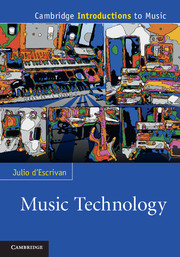Book contents
- Frontmatter
- Contents
- Preface
- Acknowledgements
- Figures
- Chapter 1 Representing and storing sound
- Chapter 2 A studio overview
- Chapter 3 Synthesisers, samplers and drum machines
- Chapter 4 Live music technology (the FAQs)
- Chapter 5 Select, remix, mashup
- Chapter 6 The producer
- Chapter 7 Music, sound and visual media
- Chapter 8 The studio as experimental lab
- Chapter 9 Controllers: new creative possibilities in performance
- Chapter 10 Hacking electronics for music
- Further avenues for exploration
- Notes
- Glossary
- Bibliography
- Index
Chapter 8 - The studio as experimental lab
Published online by Cambridge University Press: 05 June 2012
- Frontmatter
- Contents
- Preface
- Acknowledgements
- Figures
- Chapter 1 Representing and storing sound
- Chapter 2 A studio overview
- Chapter 3 Synthesisers, samplers and drum machines
- Chapter 4 Live music technology (the FAQs)
- Chapter 5 Select, remix, mashup
- Chapter 6 The producer
- Chapter 7 Music, sound and visual media
- Chapter 8 The studio as experimental lab
- Chapter 9 Controllers: new creative possibilities in performance
- Chapter 10 Hacking electronics for music
- Further avenues for exploration
- Notes
- Glossary
- Bibliography
- Index
Summary
Throughout this book, we have been looking at different aspects of the sound studio. I feel that a particular approach mentioned in the chapter on production (Chapter6) should be examined here in more detail: the recording studio as a place for creation and experimentation, beyond recording instrumental performance. In this chapter we look at the implications of this, and consider more closely the issue of creativity in the studio.
We know that once we have captured sound we can do all sorts of interesting things with it beyond playback. The idea of the studio as a music laboratory, a place (or virtual environment) for testing, experimentation and synthesis, is well established today. And, thanks to laptops, smartphones and tablet computers, quite sophisticated recording, editing and synthesis facilities are portable as well.
Earlier, in Chapter 6, when discussing music production we touched on this topic lightly, but I think it is worth exploring it some more. Are we ‘cheating’ when we present music that has been made by editing choice recordings? For example, when we take the best of four guitar solos and keep that as our recorded ‘performance’, are we misrepresenting ourselves as players? Is it any different if the music is based largely on sounds not made by musical instruments (and so, not expected to be ‘live’ anyway)? Maybe some of the answers are obvious to you, maybe not, but these questions keep coming up among young musicians and are worth considering if we are prepared to view recording as a creative tool. Let's now outline a brief overview of how the studio evolved as a place for experimentation.
- Type
- Chapter
- Information
- Music Technology , pp. 144 - 161Publisher: Cambridge University PressPrint publication year: 2011

